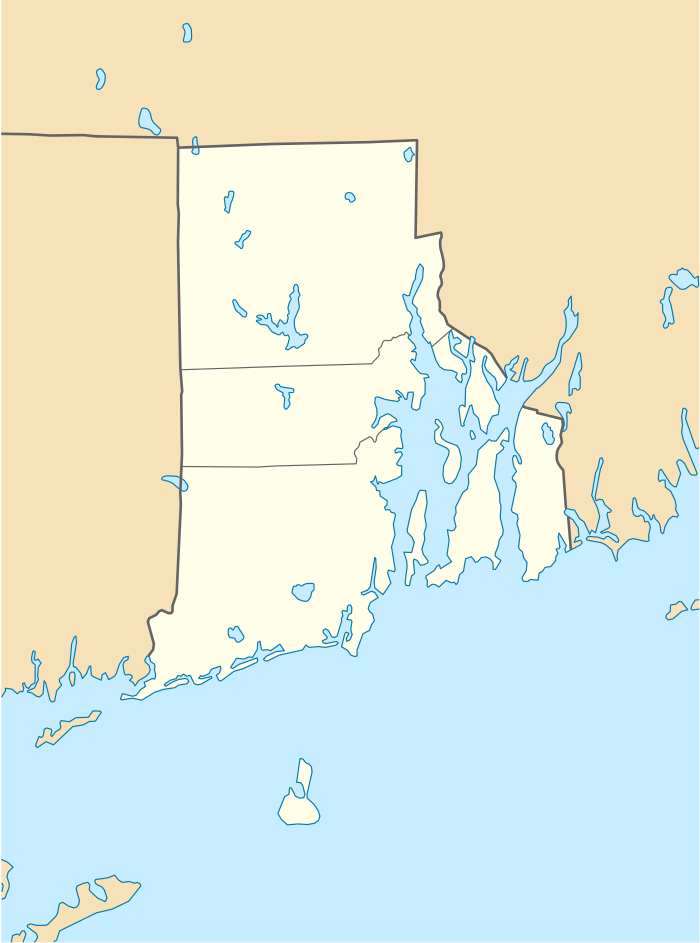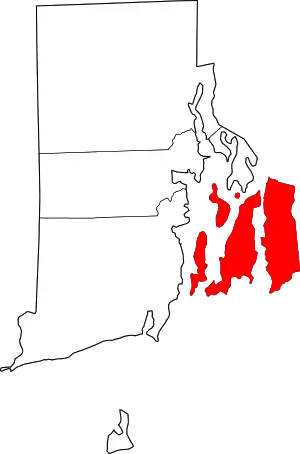Melville, Rhode Island
Melville is a census-designated place (CDP) in the towns of Middletown and Portsmouth in Newport County, Rhode Island, United States. It lies along the shore of Narragansett Bay. The population of the CDP was 1,320 at the 2010 census.[2]
Melville, Rhode Island | |
|---|---|
 The Ice Cream Train | |
 Melville, Rhode Island Location in the state of Rhode Island | |
| Coordinates: 41°35′16.37″N 71°17′3.67″W | |
| Country | United States |
| State | Rhode Island |
| County | Newport |
| Area | |
| • Total | 5.1 sq mi (13.1 km2) |
| • Land | 2.2 sq mi (5.6 km2) |
| • Water | 2.9 sq mi (7.5 km2) |
| Population (2010) | |
| • Total | 1,320 |
| • Density | 260/sq mi (100/km2) |
| Time zone | UTC-5 (Eastern (EST)) |
| • Summer (DST) | UTC-4 (EDT) |
| FIPS code | 44-45010[1] |
Military history
Melville was the site of the Lovell General Hospital during the American Civil War.
In the late 1800s Melville became the site of a U.S. Navy coaling station which was later converted for use as a fuel oil depot.
During World War II, Melville was the site of a PT boat officer training center, the Motor Torpedo Boat Squadrons Training Center.[3] It was closed after World War II ended. Among the officers trained there was future President of the United States John F. Kennedy.
After the Navy's withdrawal from Melville in 1973, the site was redeveloped into a boat yard.
The Navy, as of 2020, uses land in Melville for housing and recreation areas.
Geography
According to the United States Census Bureau, the CDP has a total area of 13.1 km2 (5.1 mi2). 5.6 km2 (2.2 mi2) of it is land and 7.5 km2 (2.9 mi2) of it (57.23%) is water.
Demographics
As of the census[1] of 2000, there were 2,325 people, 764 households, and 637 families residing in the CDP. The population density was 415.6/km2 (1,076.7/mi2). There were 1,012 housing units at an average density of 180.9/km2 (468.7/mi2). The racial makeup of the CDP was 78.97% White, 9.46% African American, 0.47% Native American, 4.65% Asian, 0.13% Pacific Islander, 2.92% from other races, and 3.40% from two or more races. Hispanic or Latino of any race were 8.39% of the population.
There were 764 households, out of which 61.5% had children under the age of 18 living with them, 74.7% were married couples living together, 6.8% had a female householder with no husband present, and 16.6% were non-families. 14.3% of all households were made up of individuals, and 1.8% had someone living alone who was 65 years of age or older. The average household size was 3.02 and the average family size was 3.36.
In the CDP, the population was spread out, with 37.8% under the age of 18, 9.5% from 18 to 24, 45.9% from 25 to 44, 5.4% from 45 to 64, and 1.4% who were 65 years of age or older. The median age was 26 years. For every 100 females there were 101.6 males. For every 100 females age 18 and over, there were 103.4 males.
The median income for a household in the CDP was $37,314, and the median income for a family was $40,134. Males had a median income of $42,500 versus $20,813 for females. The per capita income for the CDP was $14,789. About 7.7% of families and 7.3% of the population were below the poverty line, including 9.5% of those under age 18 and none of those age 65 or over.
References
- "U.S. Census website". United States Census Bureau. Retrieved 2008-01-31.
- "Summary Population and Housing Characteristics: 2010". United States Census Bureau. Retrieved July 19, 2020.
- Video of training at the center
